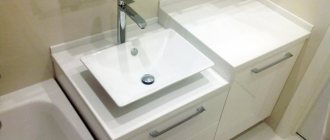Connecting a washing machine in the kitchen
Unpacking the washing machine
It is very important to unpack the equipment correctly so as not to tear the box and damage the machine. You need to open the box, take out the washing machine, remove the plastic packaging and foam protection sheets, put them back in the box
Afterwards, remove the shipping bolts from the washing machine and install the decorative inserts that are included in the kit into the holes.
Leveling the washing machine
We transport the equipment to the installation site and place it on a special mat or stand, adjust the legs and set the washing machine strictly at level.
You can check the installation of the equipment in a simpler way, for example, gently press it vertically down on each corner. If the car does not wobble, it means it is aligned correctly.
Connection of water supply and discharge
The next stage of installation is connecting the water supply and discharging it into the sewer. This is very easy to do; you just need to have the necessary tools, adapters and stopcocks on hand.
Initially, we connect the sewerage through a special adapter. We connect the hose from the kit to the washing machine and lead it to the sewer drain, which should already be organized. Try not to kink or kink the hose, which can lead to unpleasant situations.
Afterwards, we connect the hose for supplying water to the washing machine, which comes with the kit, to the rear panel, where there is a special entrance. The hose is clamped with a plastic nut, which is done very simply and manually. The other end of the hose is connected to the water supply, always with a shut-off valve installed at the connection.
Placing a washing machine in the kitchen - main benefits
The dream of modern housewives is to create a functional classic kitchen filled with technical assistants of various types. Many representatives of the fair sex prefer to choose built-in appliances, which helps save space and create an elegant interior. If there is not enough space in the bathroom to install such a large unit, the washing machine has to be placed in the kitchen. To profitably and successfully hide it inside a kitchen unit or close it with a door, you need to consider a built-in option.
The washing machine can be installed in a DIY kitchen island
Built-in kitchens with a washing machine will allow a good housewife to do all household chores in one place, which is quite convenient. With this approach, moreover, the necessary standards and subtleties of fire safety are observed, because in a bathroom where conditions of too high humidity prevail, the use of such equipment is not desirable, especially when one of the family members is taking a shower.
Vertical installation of washing machines in a classic kitchen
Thus, the use of built-in kitchen appliances allows you to save space for other purposes.
How to install a top loading washing machine
A car with a top hatch can easily be called a practical device. Its design is thought out to the smallest detail; it has a number of significant advantages over front-facing models. If there is a power outage, a breakdown of the system or motor, the laundry can be obtained without problems, and water does not end up on the floor, threatening financial costs associated with replacing the flooring or renovating the kitchen of the neighbor below.
The main disadvantage of a vertical machine is its high cost; it is difficult and sometimes impossible to install it into furniture. Most often it is placed separately, less often installed under a folding tabletop. The second method proceeds as follows:
- Determine a place for the device.
- A section of the countertop is sawed off over a specific area.
- Open edges are covered with plastic or metal strips;
- The cut piece is processed and connected to the main furniture fittings. The result is a lid that opens 180 degrees.
- Fix the unit.
- Sewer lines are being installed.
- Perform the first launch.
Tips for using a washing machine in the kitchen
The main thing that raises doubts: will the atmosphere of the kitchen with a washing machine become too noisy? There is such a risk, but you can reduce the background noise from the machine - either by choosing the quietest model possible, or by closing it with a tight door.
Photo: essenziale-hd.com
Installing equipment on ceramic tiles or porcelain stoneware will also help - these floor coverings are better than all others at reducing noise from vibration. A set of measures - located behind the door and correctly adjusting the legs of the machine - will almost completely relieve you of annoying noise.
Photo: chytre-bydleni.cz
And don’t forget to provide a place in the interior of the kitchen with a washing machine to store everything you need: powders, rinse aids and other necessary things. It will be useful so that you don’t have to constantly go to the bathroom to get them.
Choice of style and materials
with a washing machine and refrigerator in a small room makes you think and calculate the best arrangement. The design of such a room is carried out in two main styles:
- Minimalism, when the kitchen is decorated with one light color tone of furniture and walls. There should be pastel colors - beige, white or milky. A small pattern on the wallpaper in the same tone as the kitchen set would look good.
- Modern, warm natural colors with a small bright accent in the form of a kitchen apron using glossy surfaces and glass that visually expand the space. Eliminate additional decorative elements and bright accents - this will overload the room.
Kitchen interior in modern style with refrigerator.
Refuse the front door; it is not relevant for the kitchen and will add additional space in the room; it is better to make the doorway in the shape of an arch or install an accordion door.
Pay special attention to the choice of materials for finishing walls and floors. Wallpaper should be moisture resistant and easy to clean
It is better to choose vinyl ones with a smooth surface; they are optimal for the kitchen area. Lay moisture-resistant laminate or linoleum on the floor.
Small kitchen with appliances without an entrance door.
Small kitchen with washing machine
A small kitchen with a washing machine is now quite common. And all because, most often, small kitchens are located in small apartments with small bathrooms in which there is simply no place to put a washing machine.
Therefore, placing the washing machine in the kitchen may be the only solution. Of course, you can not buy a car at all and do without it, but few people will agree to this, especially if there are children in the family. And so, if you decide to install a washing machine in a small kitchen, you should weigh all the pros and cons of such a decision. The main advantage is the ability to have a washing machine at all. And this is a very powerful argument. But don't forget about the downsides.
- If the washing machine is not hidden behind the kitchen facade, it often looks like an alien element in the kitchen and can spoil the overall design of the room.
- The washing machine takes up the already small space of a small kitchen. You will have less space to store dishes and other things.
- The noise of the washing machine can disturb you while cooking or eating food.
- Using washing powder in areas with food products is highly undesirable.
Preparation of communications
The washing machine is connected to three systems: sewerage, water supply and electricity.
Sewerage
There are several varieties possible here:
- Siphon under the sink - you need to install a splitter to the drain running under the sink. It will provide an outlet for the washing machine hose.
- Directly to the sewer - in this case, you will have to make a special outlet in the pipes or attach a tee when approaching the sink or bathtub.
- In the toilet or sink - the simplest and most unreliable option. Using a hook, the hose is hung on the plumbing fixtures, and the water flows out freely after washing.
Water supply
Most often, the machine is connected to cold water, and the device itself, using heating elements, heats it to the required temperature. However, some models provide connection to both cold and hot water.
It is quite simple to install an additional outlet for water on polypropylene, metal-plastic and plastic pipes. A tee with one transition to metal should be installed. If there is a free outlet on the water supply pipes, great, the task is greatly simplified! All that remains is to install a shut-off valve.
You can install the simplest ball one. At the same time, do not forget to apply sealant and flax tow. There is an alternative option: a tee with a built-in tap. They are designed specifically for washing and dishwashing appliances. It is more convenient to install such a part, but if one of the parts fails, you will have to change the entire element, and they cost a lot.
Electricity supply
For correct and safe operation, the machine is connected to a separate grounded outlet. Please be aware that if there is no grounding, the manufacturer's warranty on the unit will no longer apply.
It must be located in close proximity to the device, since connecting extension cords or straining the wire is not allowed.
If there is no outlet that meets the stated requirements, contact an electrician. It will extend a separate power supply line from the panel with the required current parameters.
Washing machine in the kitchen - great or impractical
Kitchens with a built-in washing machine are a fairly new phenomenon in our country. To some, this solution seems like an excellent option, while others are skeptical about all design solutions and consider this option not acceptable. Let's figure it out.
Most often you can find a washing machine in the kitchen in small apartments. Why? It's simple - sometimes bathrooms are so tiny that there is simply nowhere to put the unit. But despite the compressed parameters of the apartment, the designers still found a way out - to install the machine in the kitchen set under the countertop. This type of work can be called quite simple, so most men do it with their own hands.
Positive and negative sides
Built-in household kitchen appliances
There is no consensus on this matter, and only those who have this household appliance installed in the kitchen can draw a conclusion. Now we will consider the main positive features and disadvantages of such placement, so that later we can draw the right conclusion with a clear conscience.
As always, let's start with the positives:
- More free space. By mounting the washing machine under the countertop and closing it with doors, you can save about 1 m², which is quite a significant figure in cramped conditions;
- Ease of installation and connection. Thanks to its close location to communications and special adapters, the washing machine can be placed next to the sink - now you will not be bothered by protruding hoses and tubes;
- Possibility of wide choice. Now that the washing machine is installed in a kitchen unit, you can choose any model, even one with a depth of 60 cm or more (it all depends on the place in which the machine will be installed).
Flaws:
- In general, according to the rules for using this household appliance, the door should be left open after washing. This circumstance in a kitchen is not only not practical, but also not aesthetically pleasing;
- A washing machine in the bathroom can serve as an excellent place to store dirty laundry, but this cannot be done in the kitchen (laundry left in the wash for a long time begins to smell not very pleasant);
- And finally, the last thing - food and household chemicals (washing powder, conditioner, water softeners, etc.) are not the best combination, because even if you carefully pour the powder into the machine tray, small particles will rise into the air and settle on food.
Selecting a unit
Built-in machine Teka LI4 1080E
Before answering the question - how to integrate a washing machine into kitchen furniture, let's consider such an aspect as choosing a suitable unit.
- Built-in machine models do not have a very attractive appearance compared to free-standing washing units, but in our case this is not a mandatory criterion. As a rule, most buyers are confused by the fasteners that are located on the right and left on the front side. They are designed to attach a decorative door that is customized to your kitchen set.
- In most cases, built-in washing machines are hidden under the kitchen countertop and covered with doors. Before purchasing a new unit, check the dimensions of your kitchen - perhaps the model you like simply will not fit into the niche intended for it. As a rule, washing units have a standard size - depth 57 cm, width - 60 cm, height - 85 cm, so you are unlikely to have problems.
Ideally selected unit for the size of the kitchen unit
- If you are buying not a domestic, but an imported model, then the product insert must be marked “EEC Criteria”, which must indicate the characteristics of the machine that meet all European quality standards.
- As for consumer indicators, built-in and free-standing machines are completely identical. The price for built-in models is slightly lower than for free-standing ones, but this criterion does not mean anything - you can often find a built-in model that is several times more expensive than a free-standing unit of average cost.
Advantages and disadvantages
The main advantage of a built-in unit is that you can place a full-sized model in the kitchen, which does not fit in a small bathroom. Other advantages include:
- Ease of connection, since all communications are located in one place.
- Using the space above the machine.
- You can install any model in the kitchen.
In addition to the advantages of installing in the kitchen, there are disadvantages that you need to be aware of in order not to harm your health:
Undesirable placement of a basket of dirty laundry in the kitchen.- Difficulty in rearranging when changing design.
- Incompatibility in the styles of the kitchen space and the car.
- The need to arrange an additional compartment for storing dirty linen.
- An open door to ventilate the machine after finishing washing is obstructive.
- Dirty laundry in the car is a source of unpleasant odors.
- The proximity of washing powder and products.
- The washing machine in the kitchen is a source of noise.
- Strong vibration during operation due to improper installation causes breakdowns of kitchen appliances.
If you plan to store conditioner and powder next to the washing machine, then leave 20 cm between the cabinet wall and the equipment.
Installing a washing machine in the kitchen: subtleties and nuances
You need to start by understanding one simple truth - not every washing machine can be placed under already installed furniture. Surely some centimeter will not allow you to do this without much difficulty. It is for this reason that you need to think about installing a washing machine under the countertop in advance - you don’t have to make any special cabinets for this. The machine simply slides under the tabletop between the bedside tables and that’s it. If you want to hang doors to hide the unsightly appearance of this unit (which is only possible with a small machine), then yes, you will have to make a simple bedside table.
Washing machine in the kitchen pros and cons photo
You should also take into account the height of the washing machine - any one here may not be suitable either. In the standard version, it does not fit under the tabletop in height by literally a centimeter or two. If the furniture is being made new, then it makes sense to raise the tabletop by this distance - this will not make the kitchen any less convenient. As an option, you can look for a washing unit with a removable top - this is, so to speak, an intermediate design between separately installed household appliances and built-in ones.
Now as for the immediate question, how to connect a washing machine in the kitchen? It's no secret that its operation requires water supply, sewerage and electric current. It is these three things that you will have to take care of when installing a washing unit in the kitchen. Let's look at them in a little more detail and clarify the situation with the question of what to connect and where?
- Water pipes. Everything here is quite simple - in the kitchen there is only one place where you can connect a washing machine to the water supply. This is the connection point for the mixer. It is in this place, or rather in the place where the cold water supply hose is connected to the mixer, that you will have to cut in a through tee with a tap. It’s not difficult - we unscrew the flexible hose and in its place, using tow, install a walk-through tap-tee for the washing machine. Now we screw the mixer hose onto one side of the tee (where there is no tap), and connect the water supply hose to the washing machine directly to the tap (its outlet is just three-quarters of an inch).
- Sewerage. With draining, things are even simpler. There are two options here - the washing machine drain can be connected either to a siphon or directly to the sewer. In the first situation, you will need to replace the siphon - you need one that has a special pipe for connecting the washing machine. And in the second situation, the existing siphon must be disconnected from the sewer, a standard sewer tee must be installed, in one outlet of which connect the sink siphon, and in the second - the drain hose of the washing machine. In the latter option, a rubber cuff is used to seal the drain of the machine into the sewer.
- Electricity. Solving the issue of supplying electrical power to a washing machine is somewhat more difficult than connecting it to the water supply and sewerage system - this is a powerful device for which you need to create a separate line equipped with an individual circuit breaker. This is not a problem if you think through everything in advance at the renovation stage - if the renovation has already been done, then, naturally, no one will want to hammer into the walls. By and large, there are no special options except to pull a separate branch. The main thing here is to think about how to do this with the least losses. You may have to lay external wiring and hide it with a cable duct. Alternatively, you can try connecting to the outlet from which the hob is powered - in this situation, you need to use the electric hob with the machine one at a time, so as not to create a large load on the electrical wiring.
In general, this is the entire installation of a washing machine in the kitchen - there is nothing complicated and nothing beyond the ordinary here. Everything is standard.
To conclude the topic about how to install a washing machine in the kitchen, there is only one thing left to add - in particular, to say a few points that will help hide this household appliance installed in the kitchen in the best possible way. Firstly, if the kitchen area allows, the machine can be installed in a corner - in these places, the depth is usually greater, which allows you to close even full-size household appliances with doors. Secondly, you can buy a narrow washing machine and install it anywhere in the kitchen - such equipment will be closed with doors in any case.
What is needed to install the machine under the countertop?
Correct installation of a washing machine under the countertop in the kitchen depends on the technical characteristics of the device and the features of connecting it to the communication line. It may be necessary to provide an additional outlet, but calculation of the load on the electrical network is important here.
Connecting a washing machine to water involves installing a tee tap. In this case, an important parameter is the length of the inlet hose, which must be taken into account.
To install the machine under the countertop, you must use the following tools:
- building level;
- seal;
- measuring tool;
- automotive sealant;
- pliers;
- wrench.
Options for installing a washing machine
To install the unit, you can use one of 3 methods: place it next to the set or at a distance, build it completely into it or under the countertop. In order to embed the device, you can make a furniture frame for it, which will not differ from the main set.
Full embedding
Built-in washing machine behind the facade of the kitchen unit
This installation allows you to completely hide the machine behind the facade of the kitchen unit, all the upper surfaces will become single. This will help you achieve a neat, seamless interior. Visually, the room will seem more spacious. This method is well suited for Khrushchev buildings. The difference between built-in models and conventional ones is the absence of sides and an upper decorative wall. There are hinges on the front panel; the facade is installed on them. The disadvantages of built-in washing machines include high cost and a small range. If repairs are necessary, you will have to remove the door and take out the machine.
Under the sink
Compact installation of a washing machine under the sink
Some owners of small apartments install a washing machine under the sink
When choosing a model, you need to pay attention to its height. You should buy a model no higher than 70 cm, otherwise it will be difficult for children to use the sink
A device built under the sink should have a depth of about 0.5 m. We must not forget about the gap behind the back wall; it is needed for a flat siphon and communications.
The sink should have the shape of a water lily, maximum height 20 cm. It is necessary that the drain does not touch the equipment. The advantage of this placement is that it saves space, but there are many disadvantages:
- only a small machine will fit;
- the drain in the water lily sink often becomes clogged;
- a special siphon is required for installation;
- There is a high probability of water getting on the control board, which will lead to serious damage to the device.
In a separate closet
In a separate closet
The machine will be hidden behind the front of the cabinet. The appearance of the furniture composition will become aesthetically pleasing. If the kitchen interior is designed in a certain style, this solution will be ideal. For example, this installation option is suitable for a classic style.
Under the bar counter
Today, kitchen-living rooms with a bar counter that divides the room into 2 zones are in fashion. Instead of shelves, a washing machine is placed in the free space under it. They close the doors from the outside, and then you can’t see her at all.
Washing machine in kitchen design
Most people agree that SMA in the kitchen can ruin the design, but many find it a very convenient solution. There are thousands of layout options. With a skillful approach, you will not spoil the design of the room, but will only transform it favorably. If you have questions about how to install the machine so that the appearance of the kitchen does not deteriorate, we will help you with this. Of course, it is initially necessary to think through such an installation, and not just put the washing machine in the corner and calmly exhale. In this situation, it is necessary to select a machine to match the interior. The best option is to install the washing machine during the main design.
Under-table installation
Don't know how to integrate a washing machine under the countertop? There's nothing complicated about it. It is recommended to order a furniture set that matches the required dimensions of your machine. In this case, the equipment will be hidden, and you will get an additional countertop. You can also make a corner kitchen. In this case, the machine built under the countertop will not interfere with movement around the room.
Built-in Model Options
You can also integrate a regular washing machine into the kitchen. To do this, you will need to make a furniture frame for the machine, which will fit perfectly into the interior and not differ from the main set. The main thing in this matter is to turn on your imagination and make all your desires come true.
We install the machine ourselves
Machine installed under the countertop
As practice has shown, built-in household appliances are extremely popular among all segments of the population: they fit perfectly into any interior, help save space, and are simply convenient. In addition, the built-in units “hide” behind the kitchen facades, never reminding you of their presence.
In order to integrate a washing machine into the kitchen you will need the following tool:
- Kitchen Cabinet;
- Roulette;
- Tabletop;
- Fastening elements and accessories;
- Screwdrivers, screwdriver, possibly a drill, jigsaw and other carpentry tools.
First, we choose the type of machine - if you want to completely hide the “washing machine” from prying eyes, then you need to opt for a fully built-in model. Not everyone can afford such a unit, but in order to turn the kitchen into a real culinary workshop without unnecessary units, you will have to spend a little. On such models it is necessary to attach a special door that can open from both the left and right sides.
Example of door fastening
You can also pay attention to models with a front loading compartment (covered with a tabletop on top). Such units provide for the removal of the lid, with further replacement with a tabletop element
In most cases, built-in models are height adjustable by raising the legs, so it is unlikely that you will not be able to fit the machine into the set. As you can see, installing a washing machine in the kitchen is an everyday matter.
Owners of small apartments with small kitchens can purchase narrow built-in machines. Such models are in no way inferior in performance and functionality, but have much smaller dimensions. There is only one “but” - the rotation speed of the drum on such units is somewhat lower, and the cost, unlike “full-fledged” models, is higher.
Narrow model Fagor 3FS-3611IT
We place the built-in unit under the countertop. But remember that some models may have difficulties. For example, it often happens that the compartment for pouring powder simply does not open, as it is pressed against the wall or countertop. What to do? Most people simply pour the powder into the drum - the operating instructions do not prohibit this and it does not affect the quality of the wash in any way.
In order to close the washing machine inside the cabinet, you need to push the device deeper under the visor and install the door. A closed door will completely hide your machine from prying eyes. Please note that to load laundry into the drum you will need to open both the cabinet door and the compartment door.
Connecting a washing machine
Drain connection
A washing machine built into the kitchen, like any other unit, requires connection. Connection means not only plugging the plug into the outlet, but also equipping a water intake and drainage system.
The connection of the above-mentioned unit must take into account several features:
- Devices that are not equipped with a special check valve that allows water to flow in only one direction cannot be installed without indicating the level of the outlet hose;
- In order to connect the washing machine directly to the sewer, you need to purchase an additional siphon. The hose itself coming from the unit is securely connected to the drain pipe coming from the sink. With this connection, leaks are completely eliminated;
- Quite often, people simply attach the drain pipe to the side of the sink, but this method is not reliable and safe.
Connect to the water supply
Connection diagram of the machine to the water supply
Once you have figured out how to connect the pipe to the sewer, it’s time to move on to connecting the system to the water supply:
- For this purpose, flexible hoses with a diameter of ¾ inches are used;
- We install a special valve to the water supply pipe (cold water), which is closed after each wash;
- To supply water, it is customary to use special outlets that come from the mixer (tees or pipes);
- The tee itself is attached to a pipe with cold water, and the hose from the washing machine and the hose from the mixer are connected to it. That's basically it.
Level the position using a level
Adjusting the washing machine
In order to reduce vibration to a minimum, the machine must be installed level. For this purpose, each product has adjustable legs. If they are not available, then you can use thick rubber inserts.
Next, we check the stability of the device - if the machine sways even a little, you will have to adjust the system again using a construction water level. The unit must stand firmly.
Kitchen design with a washing machine: secrets and subtleties
Washing machine doesn't fit in a small bathroom? No problem - you can put it in the kitchen! We explain all the rules and give useful tips for installing a washing machine in the kitchen.
Placing a washing machine in the kitchen is as easy as shelling pears, because there is everything necessary for its operation: a cold water supply and a sewer drain pipe. Usually, difficulties arise from other questions related to installation: how to find the optimal place for the machine and fit it organically into the interior? What features should you choose? How to avoid noise during washing? And this is just the tip of the iceberg.
Features of placement in small spaces
When placing a washing machine in the kitchen becomes the only way out of the situation, you need to take an extremely responsible approach to planning the location
To reduce the significance of some shortcomings and make the process of using the unit and other components of the kitchen space more convenient and enjoyable, it is important to adhere to some installation rules. Let's consider the main ones:
There is definitely no need to install the machine near an oven, hob, any heat source or other household appliance. It is important to leave a small gap of a few centimeters between the walls of the equipment and the furniture. It is necessary to ensure that the length of communications does not exceed 4 meters. This includes a water supply hose, sewage system.. Khrushchev-era kitchen with a refrigerator by the window, a full-fledged gas stove and a washing machine under the countertop
Khrushchev-era kitchen with a refrigerator by the window, a full-fledged gas stove and a washing machine under the countertop
To make the process of loading and unloading laundry convenient, the kitchen front door must open at least 90 degrees.
The width of the passage where the machine is installed must be greater than the size of the door
If you take these recommendations into account when planning the location of the washing machine and when installing it, you can avoid unpleasant inconveniences in use, and also not disturb the aesthetics of the interior.
Option for placing a washing machine in the kitchen with a ventilation ledge
Pros and cons
Is it even worth doing this? We have compiled a detailed table in which we describe all the significant pros and cons of placing a washing machine in the kitchen. We are sure she will help you decide!
| Advantages | Flaws |
| Frees up space in the bathroom. | If you choose a built-in installation, repairing the machine becomes more difficult. |
| All necessary communications have already been carried out. | You need to think about where to store dirty things, powder, rinse aid, etc. |
| You can install a full-size (60 cm) model - it often simply does not fit in the bathroom. | Takes up space that could be allocated for kitchen utensils or food. |
| Safety. There is less moisture in the kitchen, which means the risk of short circuits is reduced. | An open door sometimes gets in the way, but you definitely need to ventilate the washing machine... |
As you can see, the disadvantages are mainly related to ease of use. But with the correct placement and selection of a washing machine of the required dimensions, they can be avoided. What options are there for placing the machine? We'll see now.
Tips and tricks from designers
Refuse rough texture when designing the interior in a small kitchen, which will visually take over your space; it is better to choose smooth, mirror surfaces.
Small kitchen set with refrigerator and gas stove.
Do not hang bright curtains on the windows - this additional bright accent will be inappropriate in a small room.
The linear arrangement of furniture visually lengthens the space and is not suitable for narrow rooms.
When choosing bright furniture, choose a solid color with a minimal amount of decor.
Corner layout of a small kitchen using a window sill.
Any kitchen area can be designed ergonomically and stylishly. With the correct arrangement of the necessary furniture and equipment, even a small space will be comfortable and cozy.
Corner kitchen with washing machine in Khrushchev: accommodation options
In Khrushchev, the kitchen area is 6 square meters. m. It is not easy to place household appliances and furniture in such a limited space. But designers suggest using several rules for optimal design:
- In a small room, the best option would be a corner kitchen with a washbasin in the corner. In this case, the washing machine is installed in a ratio of 2:3 with other devices or symmetrically relative to the corner itself. The first option is suitable for the refrigerator, the second - for the oven;
- There should be a drawer between the device and the washbasin cabinet. This option will not only be a stylish solution, but also correct from a security point of view.
By and large, these recommendations are relevant for kitchens from 6 to 15 square meters. meters and concern compliance with proportions.
Placement of the washing machine relative to the oven
In this case, a symmetrical location from the sink is most often chosen. If there is enough space, the oven is installed at a greater distance from the sink than the washing machine. This solution is an excellent option not only in terms of functionality, but also in appearance.
Kitchen with refrigerator and washing machine
Small corner kitchens with a refrigerator and washing machine are not only attractive in appearance, but also have functional placement. As a rule, large household appliances are located on opposite sides of the corner kitchen, this also applies to built-in units. The refrigerator most often closes the long wall. This applies to kitchens of 9-15 square meters. m.
If you do not have sufficient experience in installing a washing machine, contact a specialist. You will not only be provided with prompt professional assistance, but will also be provided with a guarantee for the work. And if suddenly something doesn’t suit you, you can contact a specialist at any time and use the services for free.
Main stages of work
After approval of the project and installation of the kitchen unit, the installation of the device is carried out directly. Fully built-in appliances, as a rule, during the installation process provide for the presence of a furniture plinth at the bottom of the machine. For this purpose, there is a special recess on the body. The height is adjusted with special legs. The front door is attached to the machine body with special hinges. Connecting to communications is carried out in the same way as connecting classic devices.
The integration of a free-standing machine into a set begins with removing the top cover. Sometimes the top of the case is covered with a special plate, which is included in the kit. Next, all overall dimensions of the niche are checked and made sure that they correspond exactly to the dimensions of the built-in machine.
Washing machine hose connection diagram.
After this, the water supply and sewer drain are connected. When calculating water communications, it is advisable to take into account the length of the supply hoses, that is, there must be a certain reserve that will allow, if necessary, to pull the washing machine out of the unit without disconnecting the pipelines.
The pressure hose is connected to the water main using a tee, which is installed in a convenient place where there are threaded connections, for example, at the point where the mixer hose joins the cold water pipeline. A shut-off valve is installed between the outlet of the tee and the pressure hose of the machine. It is possible to install a tee directly into the main by welding it into a plastic water supply or using a fitting connection.
The drain hose can be connected in two ways. In the first case, a special drain siphon is required in the kitchen sink, which has an outlet for connecting a hose. In the second case, a tee is inserted into the sewer bed running in the kitchen, and a drain pipeline is connected to it
It is important to remember here that before entering the sewer, the drain hose must have an elbow-shaped bend 45-50 cm high
Layout of sockets when connecting a washing machine.
The electrical part includes the presence of a power outlet or residual current device in the apartment circuit. If this is not available, then it is possible to install a special socket in which an RCD is built-in
It is important to remember about grounding; if it is not provided for in the house design, then the presence of an RCD is mandatory, and grounding of an earthen allotment is strictly prohibited
After connecting the communications, the washing machine is pre-installed in the niche of the unit; during the installation process, the location of the hoses is monitored, while avoiding their kinks. Then a test run of the device is carried out and an inspection is carried out for leaks. After this, the machine is finally installed, maintaining the level. At the final stage, facade doors are hung, if they are provided for in the project.
Sometimes the order of work may change, this is due to some points and features of assembling the headset. For example, connection to pipelines can occur after installing the device in the suite, through adjacent cabinets. This is not a very good installation option.
Main stages of installation
Before installing the device, you need to evaluate the room. Perhaps the installation will become impractical and it is worth taking a closer look at the hanging model, which is located in a small space. To save square meters, the machine can be installed in a box or corner. Placing it close to utilities minimizes the likelihood of pump overload , so it is better to install the equipment near the sink.
An important point during installation is to take into account that the equipment will vibrate when spinning or when the drum is not fully loaded, so the floor in the kitchen must be level. This drawback can also be eliminated by adjusting the legs and additional fastening. It is necessary to leave a gap of 2 cm between the equipment and the wall. Basic installation rules:
- The device is closed with a door only at the front, and left open at the back to improve air circulation.
- They are installed on a cabinet separate from the cabinet or ensure stability on the cabinet base.
- It is not recommended to place electrical appliances and kitchen utensils on the washing machine.
Sometimes difficulties arise with placing equipment in standard headsets, but this problem can be solved by ordering equipment or a custom-made headset. If the color of the facade of the set and household appliances is different, then to create visual unity they are covered with film or painted.
Advantages and disadvantages
Minuses:
- You need to decide on the installation right away, since changes are quite difficult to make;
- The appearance of the machine does not always match the facades and spoils the overall picture of the interior (for example, modern design of equipment and classic style of furniture);
- Need additional storage space for dirty clothes;
- Opening the door after the wash is completed may interfere. In this case, ventilation is necessary, otherwise mold will appear;
- Soapy substances are released into the air. This combination with food is undesirable.
Pros:
- All necessary communications are located within the premises, so connecting the machine will not cause much trouble;
- The washing machine does not take up space in the bathroom;
- You can choose a full-size model (up to 60 cm). This is not always appropriate in a compact bathroom. Such machines are more stable due to their weight.
Modern housewives increasingly prefer to install washing machines in the kitchen and choose equipment that can be mounted directly into a furniture set. Washing machines built into the kitchen allow you to solve two problems at once: save space in small areas and fit the equipment perfectly into any interior.
Advantages:
placement in the kitchen frees up space in the bathroom, which is especially important if it is small; placement next to the kitchen sink makes it easier to connect the unit to communications for collecting and draining water; it is easier to accommodate a large car; The device can be easily hidden behind kitchen facades so that it will not be visible at all. Flaws:. Flaws:
Flaws:
- not all models can be built in height;
- Often, for machines built into cabinets, access to the compartment for washing powder is difficult;
- there is nowhere to put dirty things in the kitchen;
- After washing, the unit must be dried by keeping the door open, which is not always convenient in the kitchen;
- It is unsafe to store and use washing powder near food.
When choosing the location of a household appliance, it is wise to give preference to a place in close proximity to the kitchen sink. This will simplify connecting the machine to communications for draining and collecting water.
If this is not possible, you should not only take additional care of the connecting hoses for extension, but also think about how to hide them. It is better to install the machine away from the oven, otherwise it is important to ensure good thermal insulation. The best option is to mount the machine under a common countertop or place it behind a separate door. This allows not only to perfectly fit the unit into the interior, but also to reduce the noise level
This allows not only to perfectly fit the unit into the interior, but also to reduce the noise level
The best option is to mount the machine under a common countertop or place it behind a separate door. This allows not only to perfectly fit the unit into the interior, but also to reduce the noise level.
The top-loading unit can be conveniently placed in the corner of the room.
Advantages and disadvantages of installation
Will the washing machine be in the way in the kitchen? It's difficult to give a definite answer. For some, this arrangement is not a hindrance, but for other people it is unacceptable. And in most cases, the kitchen area plays a huge role. Therefore, it is worth considering in detail the positive and negative aspects when installing a machine in the kitchen. Let's start with the advantages:
- You don't have to install the machine in the bathroom, which means there will be much more space there.
- You can perform several actions at the same time. The washing is going on, and you are cooking. In this case, you don’t have to drop everything and run to the bathroom to monitor the washing process.
- Due to the fact that there is more space in the kitchen, you can without a doubt purchase a full-sized washing machine. The space in some bathrooms does not allow for a large and capacious machine.
Flaws:
- It is unlikely that you will be throwing dirty laundry around in the kitchen. You can install a special basket for this in the bathroom. In the kitchen there is nowhere to place a linen drawer or basket.
- There is also no place to store household chemicals in the kitchen. Moreover, storing powders near food is a risky business. This means you have to run to the bathroom before every wash.
- Kitchen appliances can often get dirty. Therefore, the occurrence of greasy stains and drips is normal.
- Difficulties may arise when installing vertical type washing machines. You will have to order a cabinet with a folding tabletop - this is very inconvenient.
You see that there are more minuses than pluses, but this should not scare you. For example, a separate niche in the kitchen unit is suitable for storing washing detergents and a basket with dirty laundry. The same applies to stains that occur during cooking. If the niche is covered with doors, nothing will get on the body of the machine.
Recommendation! Installing a washing machine in the kitchen will significantly save space in the bathroom. Have you dreamed of a Jacuzzi or a large shower? Send SM to the kitchen and the bath is yours.
Models of washing machine for the kitchen
Choosing the appropriate option is a simple task that is easy to cope with, but there are some nuances here. For a large room, any equipment is suitable; for small rooms, the number of possible types of objects is small. First of all, it is necessary to decide on a number of basic parameters inherent in different products, namely:
- type of laundry load;
- overall characteristics;
- installation method.
You should also take into account a number of criteria that play an important role: noise level, energy saving class, spin class, type of control, the presence of child protection, leak protection, and other additional features. If you decide in advance on all the features, then the number of specific models that will meet the requirements is reduced to a minimum.
By way of loading laundry
According to this parameter, all devices are divided into two types: frontal, vertical. In the first case, the laundry is loaded through a hatch located on the front side of the product, in the second, things enter the tank from above. Both options perform the same function, but there are no fundamental differences in the quality of washing. Let's take a closer look at each type:
- Frontal. The most popular model. It is characterized by a relatively low cost and the ability to monitor the washing process through a transparent window located on the door. It can be built into furniture and will fit perfectly into any kitchen interior. However, you will have to bend down when loading things, and you will need free space to open the door.
- Vertical. It is possible to add an item while washing; you don’t have to bend over to load laundry; the lid comes off upward, so there is no need for free space on the side. But this option costs a quarter more than the horizontal one, and it cannot be built into furniture.
If we compare both types, then in most cases preference is given to the first. This is due to the more advantageous appearance of the front products, the ability to use the top panel as an additional shelf, and they can also be built into furniture or placed under the sink.
Dimensions and size
When choosing the dimensions of a washing machine, take into account the space allocated for it, as well as the installation method, whether it will be a free-standing model or it must be built into the kitchen unit, closed with a door. There are various products that can be easily installed in any place, even the most inaccessible one. Using the table as an example, we will consider the existing types of equipment depending on size:
| Dimensions | Frontal | Vertical | |||
| Full size | Narrow | Ultra-narrow | Compact | ||
| Height, cm | 85-90 | 85-90 | 85-90 | 68-70 | 85-90 |
| Width, cm | 60 | 60 | 60 | 47-50 | 40 |
| Depth, cm | 60 | 35-40 | 32-35 | 43-45 | 60 |
| Loading, kg | 4-7 | 3,5-5,2 | 3,5-4 | 3 | 4-7 |
Built-in or freestanding
Manufacturers, taking into account the needs of the consumer, produce different models of equipment, which, according to the installation method, are divided into two types: free-standing, built-in. Each type has its own advantages and disadvantages. To choose the right product, let’s look at each option in more detail:
- Freestanding unit. The most common type of washing machine. From the name itself you can understand that the item will be located separately from the furniture set, stand away from the refrigerator, gas, electric stove, kitchen table. Some specialists manage to build in such models, which ultimately leads to a reduction in their service life.
- Embedded devices. In turn, they are divided into two types: fully built-in, with the possibility of embedding. The first type is completely covered with kitchen furniture panels. The second one can be installed under the tabletop, placed freely. Unlike standard ones, built-in products are protected on the sides by durable metal sheets. The main feature, except that they are not visible, is the absence of noise and vibration during the washing process, which is achieved by rigidly fixing the unit.
Methods for integrating washing machines into kitchen units
The washing machine can be built in openly, when the front of the machine is not covered by the facade, and closed, when it is completely hidden by the facade of the kitchen unit. The second option is the most preferable, since this does not compromise the integrity of the kitchen furniture. However, in order to carry out hidden installation, you need to make sure that the dimensions of the device and the furniture cabinets match. For example, free-standing full-size washing machines in most cases have a depth of about 57 cm. Moreover, due to protruding controls and the loading hatch cover, this value can increase.
Location of the washing machine in the kitchen.
The depth of the kitchen cabinet-table varies between 56-59 cm, the depth of the countertop is 60 cm. Therefore, it is not always possible to build in a classic full-size machine in such a way that its front part is covered by the facade. Here it is important to remember the permissible distance between the back of the machine and the wall, and the communication hoses should not be pressed tightly against anything.
To integrate a full-size machine into a kitchen set, it is better to choose built-in devices. Due to their geometric dimensions, they can be installed taking into account the front door. As a rule, the front door is attached directly to the body of the machine; there are appropriate fasteners for this. This fact allows you to minimize the gap and achieve the required compactness. Reduced depth washing machines make it easy to install them in any way.
A free-standing version of washing units is usually installed between two adjacent cabinet boxes; if the project has front doors, then they are attached to the outside of their body. Sometimes the headset design includes a separate cabinet for the typewriter. The top cover of most devices is removable, this allows you to slide the machine body under the countertop.
When drawing up a kitchen project that contains built-in washing appliances, you need to consider the following aspects:
- trouble-free access to water communications;
- convenient location of the machine in the kitchen space (the dominant role is given to the main purpose of the kitchen);
- hard floor covering where the machine is installed;
- Possibility of service or emergency maintenance.
Washing machine dimensions.
It is advisable, if the kitchen area allows, to space out the installation locations of washing machines and ovens. This will avoid temperature changes and possible overheating. If this is not possible, then it is necessary to install a heat-insulating screen between the machine body and the oven.
The kitchen must be equipped with wiring that meets the requirements for connecting the electrical parts of machines. All work on laying or changing communications and electrical lines must be carried out before installing the headset and take into account the future location of the washing machine.











